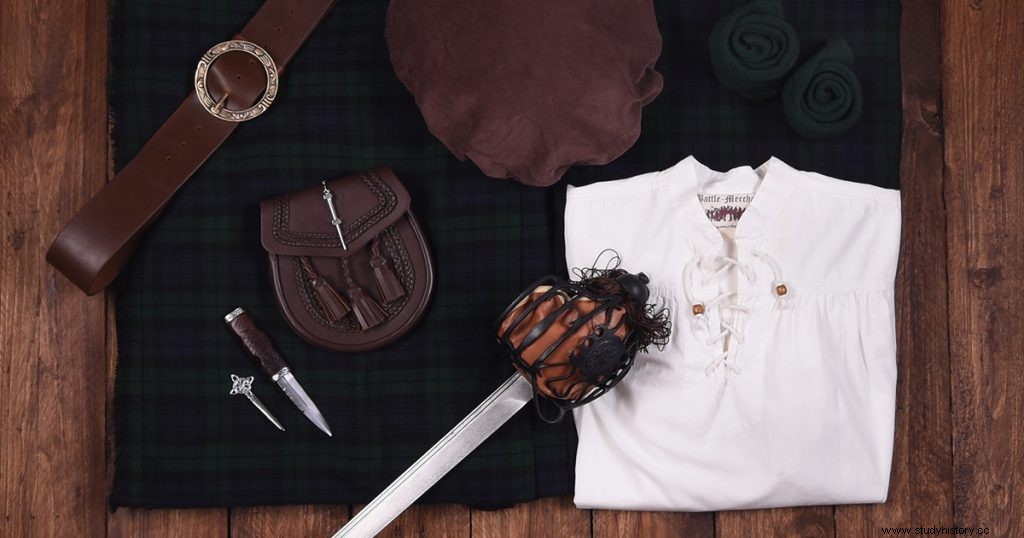Who doesn't know them, the wildly romantic stories from the Highlands. Strong men who fight for pride and honor in a breathtaking landscape and brave the tough winds. If you think of the Highlanders, who defend their barren land against the English with their swords and who sit comfortably by the fire in the evening with whiskey and play the bagpipes, the kilt automatically comes to mind. The garment is cult and culture and every real highlander has at least one checkered kilt in the closet. The story behind the clothing typical of the country is as exciting and robust as the inhabitants of the Highlands themselves.
The origins of the kilt
To put it bluntly, the origins of the kilt are in the mist, much like the top of Ben Nevis on a cloudy day. The mysterious does not detract from the popularity of the plaid. On the contrary, the knee-length skirt is surrounded by legends and is therefore of inestimable value for all lovers of Scottish culture.
The “Great Belted Plaid” was the forerunner of the kilt known today and consisted of a one and a half meter wide and four to eight meter long panel of fabric. Since the weavers at that time could only weave fabric panels with a maximum width of 80 centimeters due to the technology, they sewed two fabric panels together without further ado. They used a belt to fold the fabric and fasten it around the waist. As you can imagine, that was a lot of stuff. So the belted plaid wasn't necessarily comfortable, and certainly not easy to put on. It was also a source of fire, so the Belted Plaid 1725 - and that's just an assumption - was superseded by a more practical version.
The Scottish employees in their long lengths of fabric at the blast furnace were too dangerous for the manufacturer Thomas Rawlinson, so he provided a shorter version. In addition, the pleats were sewn in at the same time, eliminating the need for tedious wrapping.
By the way, before the kilt and the belted plaid, the Highlander wore trousers and long tunics.
Every clan has a pattern, right?
The tartan skirt is still characterized by different check patterns in a very classic way. Dark green, brown, wine red or dark blue are popular colors and you've probably heard that the color and check pattern varies depending on the clan. This is often assumed, but according to recent findings it is more likely that the pattern changed depending on wealth.
Incidentally, the checked pattern is called tartan and, in addition to the wealth of the wearer, is also assigned to certain regions, the districts. Depending on the region - not the clan - the Highlanders preferred different patterns and dyes. The theory that certain patterns and colors were assigned to the individual clans would have been more than a hindrance in military conflicts. In this way you would have been immediately identified as an enemy and would have met an inglorious end in the battle rather quickly.
The Kilt Ban of 1746
The fact that you only read and hear speculation about the kilt today is mainly due to the kilt ban of 1746, with which a lot of information was lost. The great Jacobite rebellion in 1745 caused the abolition of the clans and the Disarming Act 1746 also banned the kilt. Because this was the symbol of the proud Highlander and the kilt was also far too practical. It could easily have been used as a plaid to disguise and hide in the undergrowth as a thief, assassin or rebel - so the kilt was banned.
First the law “Use of Highland Dress Act” in 1782 the ban was lifted again. Because back then, authors like James Macpherson or Sir Walter Scott created a real hype about the romantic Highlands and the kilt was reborn.

What is the correct way to wear a kilt?
The usual kilt ends above the knee for unmarried men. Those who are married or engaged traditionally cover their knees. In addition, the kilt should not touch the ground when you kneel down. This will prevent it from getting dirty.
You're probably also asking yourself what a Highlander actually wears under his skirt. Legend has it that underwear is traditionally not worn under the kilt. But that is more due to the fact that there was simply no underwear in earlier centuries. Today you can and may wear underpants under the kilt.
Many other accessories complete the Highlander outfit around the rustic kilt.
Since a kilt has no pockets, a sporran, a small leather bag, is traditionally worn over the kilt. Most place them mid-groin, as this prevents a gust of wind from exposing intimate areas.
The traditional equipment of a Highlander also includes the Sgian Dubh. The Scots hid the small knife in their stockings, because for a time it was forbidden to carry weapons due to the Disarmed Act. By the way, during a period of war it was worn on the outside of the leg, when there was peace it switched to the inside.
Battle Merchant offers you lots of authentic clothing and accessories for the perfect Highland outfit.
